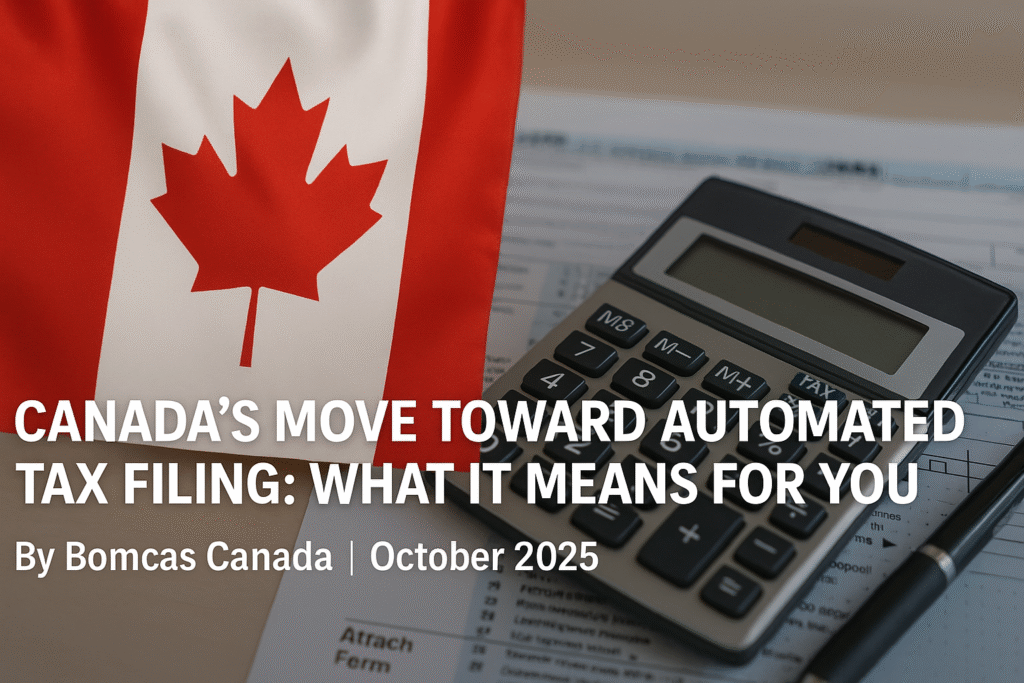By Bomcas Canada | October 2025
In a significant shift for the Canadian tax landscape, the federal government has announced that the Canada Revenue Agency (CRA) will begin automatically filing tax returns for eligible Canadians starting in the 2026 tax year, with a full rollout expected over the next few years.
This new initiative, announced as part of a broader affordability strategy, aims to simplify the tax system, especially for lower-income individuals who often face barriers in filing returns and accessing government benefits. As professional accountants and tax experts, Bomcas Canada is closely monitoring the implementation of this policy to help individuals and businesses understand what to expect — and how to prepare.
Below is a comprehensive overview of what automatic tax filing entails, how it will work, who it impacts, and what it means for you.

What Is Automatic Tax Filing?
Automatic tax filing is a system where the CRA completes and submits an individual’s tax return on their behalf, using the income and benefits information the government already holds. This system is intended primarily for Canadians with straightforward tax situations, especially those with limited income sources and no major deductions, investments, or complex reporting obligations.
Rather than requiring individuals to gather documents, navigate tax software, or pay a preparer, the government will use existing payroll, benefit, and financial data to prepare a return. Taxpayers will be given the opportunity to review or amend the return, but if no action is taken, the return may be filed automatically.
Who Will Qualify?
The automatic tax filing program will be phased in gradually. Initially, it will be available to individuals who:
- Have low or fixed income
- Have no self-employment or investment income
- Receive income primarily from employment, government benefits, or pensions
- Are not claiming complex deductions or credits
These individuals often qualify for government benefits and credits but may not receive them simply because they fail to file a return. In future phases, the system could expand to more taxpayers with moderate income or slightly more complex returns.
How Will It Work?
Here’s an overview of how the system is expected to function:
- Data Collection:
The CRA gathers existing data from employers (T4s), financial institutions (T5s), pension plans (T4A), and government programs like the Canada Child Benefit or GST/HST credits. - Return Generation:
Using this data, the CRA prepares a pre-filled return for eligible individuals. - Notification & Review:
Taxpayers are notified that a return has been prepared and are invited to review, accept, or modify it through their CRA My Account or via mailed correspondence. - Filing & Confirmation:
If the taxpayer takes no action within a specified period, the CRA may file the return automatically on their behalf. A notice of assessment will be issued as usual. - Appeals or Adjustments:
Taxpayers will retain the right to file an amended return or appeal any issues after the fact, just as with standard returns.
Benefits of Automatic Tax Filing
There are several compelling reasons why this system is being implemented — and why it could be a game-changer for many Canadians.
1. Increased Access to Benefits
One of the biggest issues in Canada’s current system is non-filing, especially among low-income individuals who assume they don’t need to file because they owe nothing. In reality, these individuals often miss out on critical benefits like:
- Canada Child Benefit
- GST/HST Credit
- Canada Workers Benefit
- Climate Action Incentive Payment
- Canada Disability Benefit (coming soon)
Automatic filing ensures that these individuals don’t miss out on money they are entitled to.
2. Simplification for Eligible Individuals
Filing taxes can be overwhelming, especially for seniors, newcomers, people with disabilities, or those with language barriers. Automatic filing removes the burden of navigating software, hiring a tax preparer, or gathering documents — making tax compliance easier and less stressful.
3. Cost Savings
For individuals with simple tax situations, the new system can eliminate the cost of filing returns via paid services or software. Over time, it could also reduce administrative costs for the CRA by streamlining processing and reducing paper-based filings.
4. Improved Tax Compliance
By increasing the number of people who file returns, the government ensures more accurate delivery of benefits and better tracking of taxable income across the population.
5. Time-Saving and Efficient
The automatic system saves time for both the taxpayer and the government. There’s less manual input, fewer errors, and faster assessments — especially for simple returns.
Pros and Cons of Automatic Tax Filing
Pros
| Pros | Explanation |
|---|---|
| Ease of Use | No need to gather documents or use software. |
| More People Receive Benefits | Helps non-filers access government support. |
| Reduced Costs | Saves money for taxpayers and the CRA. |
| Efficiency | Streamlined, faster processing of simple returns. |
| Digital Modernization | Moves tax filing into a more modern, automated space. |
| Supports Vulnerable Populations | Especially beneficial for seniors, low-income individuals, and those with barriers. |
Cons
| Cons | Explanation |
|---|---|
| Limited Eligibility | Only applies to simple returns; others still need to file manually. |
| Lack of Customization | Automated returns may miss deductions, credits, or changes in life circumstances unless updated. |
| Potential for Errors | Inaccurate or outdated data could lead to incorrect filings. |
| Privacy Concerns | Handling sensitive financial data on behalf of taxpayers may raise trust and security issues. |
| Opt-Out Process | Some may be unaware of the automatic process or how to decline it. |
| Over-reliance on Government | Reduces personal responsibility for financial reporting, which could be problematic over time. |
Implications for Tax Professionals and Accounting Firms
While this move may initially seem like a threat to tax service providers, it’s important to note that the majority of tax returns will still require professional support. Most Canadians have tax situations that go beyond simple employment income — such as:
- Rental income
- Self-employment income
- Investment income
- Foreign assets
- Claiming complex deductions
- Retirement or estate planning
At Bomcas Canada, we believe this shift opens new opportunities for firms like ours to:
- Educate clients on how automation works and who it applies to
- Assist individuals in reviewing or amending their automated returns
- Help clients opt out or correct errors in automated filings
- Continue serving the large portion of Canadians with complex needs
Rather than replacing accountants, automatic tax filing redefines how we add value — focusing more on advice, planning, and strategic tax optimization.
What Canadians Should Do Now
Even though the system won’t roll out fully until the 2026 tax year, Canadians should take steps now to prepare:
✅ Set Up a CRA My Account
Most communication for automatic filing will happen through CRA’s secure portal. If you don’t have an account, set one up now.
✅ Keep Your Information Updated
Ensure that your address, marital status, dependents, and direct deposit information are correct. The CRA will rely on existing records.
✅ Understand Your Tax Profile
If your tax situation is simple and consistent year to year, you may qualify. But if you have changes in income, family status, or investments, manual filing may still be better.
✅ Watch for CRA Notices
As the system rolls out, eligible individuals will receive notifications. Pay attention to CRA communications so you don’t miss a return or benefit.
Bomcas Canada Can Help
Automatic tax filing is a positive step for tax equity and simplification in Canada — but like any new system, it comes with caveats and complexity.
At Bomcas Canada, we are committed to helping you:
- Understand your eligibility
- Review or override automatic returns
- Claim all applicable deductions and credits
- File amended returns if the automated one is incorrect
- Provide year-round planning and professional advice
Whether you’re an individual taxpayer or a business owner, our team is here to help you stay ahead in a changing tax environment.
Conclusion
Automatic tax filing is set to reshape how millions of Canadians interact with the CRA — offering a more streamlined experience for many, while also raising important questions about accuracy, privacy, and control.
As this program rolls out in phases starting in 2026, it’s essential to stay informed, review your tax situation, and seek professional guidance when needed.
Bomcas Canada is here to support you every step of the way — now and into this new era of tax automation.










 View Our Location
View Our Location





 181 Meadowview Bay, Sherwood Park, AB T8H 1P7, Canada (Online Clients Only)
181 Meadowview Bay, Sherwood Park, AB T8H 1P7, Canada (Online Clients Only)